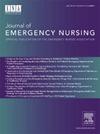Implementation of a Naloxone Vending Machine in the Public Space of an Emergency Department: A Feasibility and Acceptability Study
IF 2.3
4区 医学
Q2 EMERGENCY MEDICINE
引用次数: 0
Abstract
Introduction
Naloxone is a lifesaving medication to prevent opioid overdose deaths. Emergency departments can provide important access points for individuals to receive naloxone. Vending machines are 1 low-barrier method of distributing naloxone. We describe the implementation of an emergency department-based naloxone vending machine and demonstrate its feasibility and acceptability among participants.
Methods
A naloxone vending machine, supplying free naloxone and educational resources via a Quick Response code affixed to the box in addition to brochures, was installed in a public hallway next to other vending machines in the emergency department. A 12-item paper survey attached to the machine queried reasons for obtaining naloxone, acceptability of emergency department-based naloxone vending machines, and an open-ended question about their experiences with the machine.
Results
From October 2023 to May 2024, 1470 boxes of naloxone were dispensed. Survey results (N = 54) indicated that nearly half of respondents (46.2%) would not have otherwise had access to naloxone. Also, 75.9% obtained naloxone to be prepared for an overdose emergency, 42.6% because it was free, and 35.2% out of concern for a family or friend. High acceptability was reported for all survey items. Qualitative themes were predominantly positive, including gratitude, desire to help others, need for increased distribution, and the personal impact of naloxone in their lives.
Discussion
Emergency department-based naloxone vending machines are an impactful, low-barrier strategy that is acceptable to the public. They provide continuous access to a life-saving medication and should be replicated widely.
在急诊科公共空间安装纳洛酮自动售货机的可行性和可接受性研究
纳洛酮是一种预防阿片类药物过量死亡的救命药物。急诊部门可以为个人提供重要的接入点来接受纳洛酮。自动贩卖机是分发纳洛酮的一种低障碍方法。我们描述了一种基于急诊室的纳洛酮自动售货机的实施,并证明了其可行性和参与者的可接受性。方法:在急诊科的公共走廊安装一台纳洛酮自动售货机,除了宣传册外,还通过贴在盒子上的快速响应代码免费提供纳洛酮和教育资源。该机器附带了一份包含12个项目的纸质调查,询问了获得纳洛酮的原因、急诊室纳洛酮自动售货机的可接受性,以及一个关于他们使用该机器的体验的开放式问题。结果:2023年10月至2024年5月,共发放纳洛酮1470盒。调查结果(N = 54)显示,近一半(46.2%)的受访者本来无法获得纳洛酮。此外,75.9%的人获得纳洛酮是为了应对过量服用的紧急情况,42.6%是因为免费,35.2%是出于对家人或朋友的担忧。所有调查项目的可接受性都很高。定性主题主要是积极的,包括感激、帮助他人的愿望、增加分配的需要以及纳洛酮对他们生活的个人影响。讨论:急诊室纳洛酮自动售货机是一种有效的、低障碍的策略,为公众所接受。它们提供了持续获得救命药物的途径,应该广泛推广。
本文章由计算机程序翻译,如有差异,请以英文原文为准。
求助全文
约1分钟内获得全文
求助全文
来源期刊
CiteScore
3.10
自引率
11.80%
发文量
132
审稿时长
46 days
期刊介绍:
The Journal of Emergency Nursing, the official journal of the Emergency Nurses Association (ENA), is committed to the dissemination of high quality, peer-reviewed manuscripts relevant to all areas of emergency nursing practice across the lifespan. Journal content includes clinical topics, integrative or systematic literature reviews, research, and practice improvement initiatives that provide emergency nurses globally with implications for translation of new knowledge into practice.
The Journal also includes focused sections such as case studies, pharmacology/toxicology, injury prevention, trauma, triage, quality and safety, pediatrics and geriatrics.
The Journal aims to mirror the goal of ENA to promote: community, governance and leadership, knowledge, quality and safety, and advocacy.

 求助内容:
求助内容: 应助结果提醒方式:
应助结果提醒方式:


